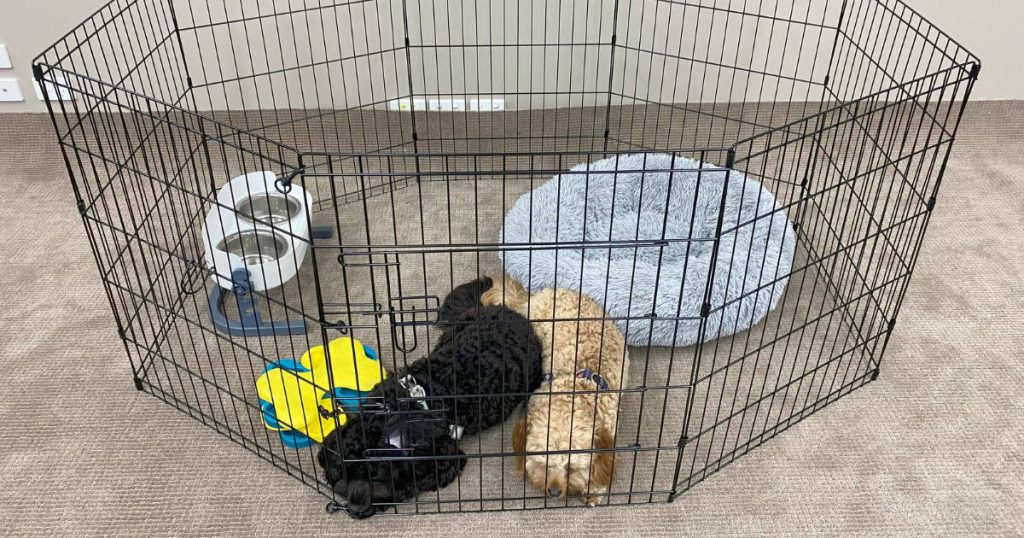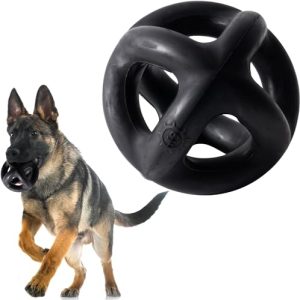If you’re a dog owner, you’ve probably wondered, “How long should my dog be in a kennel?” It’s a question that matters because keeping your furry friend comfortable and happy is your top priority. Too long in a kennel can cause stress, but too short might not give you the break you need.
You’ll discover the ideal time limits for kennel stays, how to make the experience better for your dog, and what signs to watch for to ensure their well-being. Keep reading to find out how to make kenneling a positive experience for both you and your dog.

Credit: www.petperspective.com.au
Ideal Kennel Duration
Dogs should stay in a kennel for short periods, usually a few hours to a day. Long stays can cause stress and discomfort. Regular breaks and exercise keep your dog happy and healthy.
Factors Influencing Time Limits
The ideal time a dog spends in a kennel depends on several factors. The dog’s age, breed, and health play important roles. The purpose of kenneling, such as training or travel, also matters. Dogs need breaks to stretch and relieve themselves. Long hours in a kennel can cause stress and discomfort. Monitoring the dog's behavior helps decide the right duration. Adjust kennel time based on the dog’s response and needs.
Age And Breed Considerations
Puppies require shorter kennel periods because they have less bladder control. Older dogs might need more frequent breaks due to health issues. Small breeds often tire faster and may feel confined sooner. Large breeds might need more space but can handle longer kennel times. Always consider the dog’s energy level and physical condition. Adjust kennel time to avoid anxiety or physical strain.
Behavioral Aspects
A calm dog can handle longer kennel stays than a nervous one. Dogs with separation anxiety may become stressed quickly. Positive kennel experiences reduce fear and resistance. Use toys and treats to create a safe, comforting space. Watch for signs like whining, barking, or scratching. These signs suggest the dog needs less kennel time or more frequent breaks.

Credit: www.ottawahumane.ca
Health And Safety Concerns
Kenneling dogs can be necessary for many reasons. Still, health and safety must be the top priority. Too much time in a kennel can harm your dog physically and mentally. Recognizing signs of discomfort helps protect your furry friend.
Physical Effects Of Prolonged Kenneling
Staying in a small space for long periods limits movement. This can cause muscle stiffness and joint pain. Dogs need regular exercise to keep their bodies strong. Lack of activity may lead to weight gain or loss of muscle tone. Poor circulation and sores can develop from lying too long. Proper kennel time should allow for breaks and walks.
Mental Well-being And Stress
Dogs are social animals. Isolation in a kennel can cause anxiety and boredom. Stress may show through barking, whining, or destructive behavior. Lack of mental stimulation can lead to depression. Dogs need interaction, toys, and mental challenges. A calm and happy dog feels safe and relaxed.
Signs Of Discomfort
- Restlessness or pacing inside the kennel
- Excessive barking or whining
- Drooling or panting heavily
- Scratching or biting at the kennel bars
- Loss of appetite or refusal to drink water
- Changes in bathroom habits
Recognizing these signs helps prevent health issues. Adjust kennel time and provide comfort to ease stress.
Creating A Comfortable Kennel Space
Creating a comfortable kennel space is essential for your dog’s well-being during their time inside. A kennel isn’t just a containment area; it should feel like a safe, cozy retreat. Paying attention to the details can make a big difference in how your dog perceives this space.
Proper Sizing And Ventilation
Your dog needs enough room to stand, turn around, and lie down comfortably. A kennel that’s too small can cause stress, while one that’s too large might not feel secure. Measure your dog and choose a kennel size that fits their current size and allows some extra room.
Ventilation is equally important. Good airflow prevents overheating and keeps the space fresh. Look for kennels with mesh sides or vents to ensure your dog can breathe easily and stays cool.
Bedding And Toys
Soft bedding can make a hard kennel floor much more inviting. Use washable, comfortable materials like fleece or cushioned mats. This not only adds comfort but also helps your dog associate the kennel with relaxation.
Toys keep your dog entertained and reduce anxiety. Chew toys, puzzle toys, or even a favorite blanket can provide comfort and mental stimulation. Think about what your dog enjoys most and add those items to their kennel.
Temperature Control
Maintaining the right temperature is crucial. If the kennel is too hot or too cold, your dog won’t be comfortable. Place the kennel away from direct sunlight or drafts to keep the temperature steady.
In colder months, consider adding a warm blanket or a heated pad designed for pets. During warmer seasons, use fans or cooling mats to help your dog stay comfortable. How often do you check the temperature around your dog’s kennel?
Tips For Gradual Kennel Training
Getting your dog comfortable with a kennel takes patience and a gentle approach. Gradual kennel training helps your dog see the kennel as a safe and pleasant space rather than a place of confinement. This process can reduce stress for both you and your dog, making kennel time more peaceful and effective.
Building Positive Associations
Start by placing your dog’s favorite toys or a soft blanket inside the kennel. Let your dog explore the kennel at their own pace without forcing them in. Spend time sitting near the kennel and speaking in a calm, reassuring voice to build trust.
Have you noticed how your dog reacts when you toss treats inside? This simple act can create a positive link between the kennel and good experiences, encouraging your dog to enter willingly.
Establishing A Routine
Set consistent times for kennel breaks so your dog knows what to expect. Dogs thrive on routine, so regular kennel sessions help reduce anxiety over time. Start with short periods and gradually increase the duration as your dog becomes more comfortable.
Do you notice any patterns in your dog’s behavior when kennel time is unpredictable? Regular timing can make a big difference in how your dog adapts.
Using Treats And Rewards
Reward your dog immediately after they enter or stay calmly in the kennel. Use high-value treats that your dog loves to reinforce positive behavior. Praise and gentle petting also boost your dog’s confidence and comfort inside the kennel.
- Give treats through the kennel door to encourage entry.
- Offer a favorite chew toy once inside to keep your dog occupied.
- Slowly increase the time before giving a treat to build patience.
Have you tried switching up treats to keep your dog interested during training? Variety can keep kennel time exciting and rewarding.
Alternatives To Long Kenneling
Long hours in a kennel can stress dogs and affect their well-being. Finding alternatives helps keep dogs happy and healthy. These options reduce boredom and promote good behavior. They also build a stronger bond between you and your pet.
Regular Exercise Breaks
Exercise breaks free dogs from confinement. Short walks or play sessions release energy. Exercise improves mood and reduces anxiety. Aim for several breaks during the day. Even a quick walk helps maintain physical health.
Interactive Playtime
Playing with your dog stimulates their mind. Use toys, puzzles, or simple games like fetch. Interactive play keeps dogs alert and entertained. It also strengthens your connection. Spend time daily to prevent loneliness and restlessness.
Daycare And Pet Sitting Options
Daycare centers offer social time with other dogs. Professional sitters provide care in a home setting. Both options reduce time spent alone in a kennel. They ensure dogs get attention, exercise, and companionship. Choose services that fit your dog’s needs and personality.
When To Consult A Veterinarian Or Trainer
Knowing when to seek help from a veterinarian or trainer is key to your dog’s well-being during kennel time. Some signs mean your dog needs extra support beyond just adjusting the kennel duration. Early advice can prevent bigger problems. Watch for changes in behavior or health. Expert guidance ensures your dog stays safe, happy, and healthy.
Behavioral Issues
Signs like excessive barking, biting, or scratching the kennel need attention. Restlessness or refusing to eat are also red flags. Trainers can help identify anxiety or fear causing these behaviors. Early intervention can teach your dog to feel secure in the kennel.
Health Symptoms
Look for signs of illness such as coughing, vomiting, or diarrhea. Limping or difficulty moving also requires a vet’s check. Sudden changes in bathroom habits or appetite might indicate health problems. Never ignore these symptoms while your dog is kenneled.
Professional Kennel Recommendations
Some kennels ask for a vet’s approval before accepting dogs. Trainers can provide advice on safe kennel times based on your dog’s breed and age. Professionals help create a schedule that fits your dog’s needs. Follow their advice to keep your dog comfortable and healthy.

Credit: www.care.com
Frequently Asked Questions
How Long Can A Dog Stay In A Kennel?
Dogs should not be in a kennel for more than 8-10 hours. Puppies or older dogs need more frequent breaks. It’s important to provide them with exercise, food, and water. Regular breaks are essential for their well-being and comfort.
What Factors Influence Kennel Duration For Dogs?
Several factors influence kennel duration, including the dog’s age, health, and temperament. Puppies and older dogs require more frequent breaks. The kennel environment and the dog’s previous experience with kennels also matter. Always prioritize your dog’s comfort and needs.
Is It Safe For Puppies To Stay In Kennels?
Puppies can stay in kennels, but not for long periods. They need frequent breaks for exercise, feeding, and bathroom needs. Always ensure the kennel is safe, comfortable, and suited for a puppy. Gradually increase kennel time as your puppy grows.
How Does Kennel Time Affect A Dog’s Behavior?
Excessive kennel time can lead to stress and anxiety in dogs. It might cause behavioral issues like aggression or depression. Providing mental stimulation and exercise outside the kennel helps. Balance kennel time with play and socialization for a happy, healthy dog.
Conclusion
Keeping your dog in a kennel for the right time matters a lot. Too long can make them stressed or bored. Short stays help dogs feel safe and calm. Always watch your dog’s behavior and needs closely. Give them time to stretch and play outside the kennel.
A happy dog needs balance between rest and activity. Remember, each dog is different. Adjust kennel time based on your dog’s age and health. Care and attention make kennel time easier for your pet.

Emily Barker is the founder of ChillDogLife.com, a space dedicated to helping pup parents discover the best dog products, lifestyle tips, and cozy ideas for happier homes.
A lifelong dog lover, Emily combines her passion for pets with a knack for research to share trusted recommendations on everything from toys and furniture to health and everyday care.
Her goal is simple: to make life easier, stylish, and more joyful for dogs and the people who love them.







